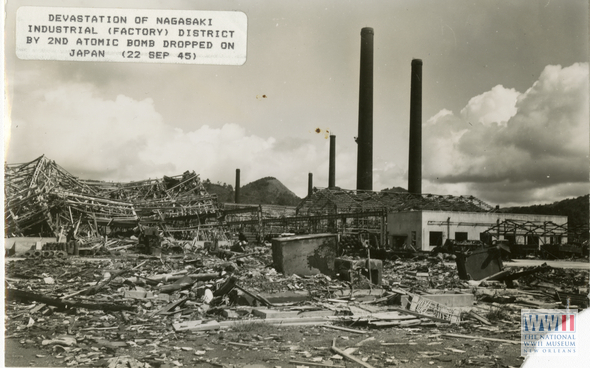COUNTDOWN TO ROAD TO TOKYO: EXHIBITS WITHIN DOWNFALL

Devastation of Nagasaki Industrial Factory District by Second Atomic Bomb on Japanese on 22 September 1945
As we come to the end of the our journey on the Road to Tokyo, we take a look at the final two exhibits within the Downfall gallery, which will examine the last ghastly months of war and the controversial military decisions that led to ultimate allied victory.
Dropping the Bomb
On August 6, 1945, the United States dropped an atomic bomb on Hiroshima, Japan. A second atomic bomb was dropped on Nagasaki on August 9. The unprecedented devastation these bombs caused brought the war to a sudden climax. This exhibit will cover the immediate effects of the bombs as well as introduce visitors to the unending debate over the morality of using these new and terrifying weapons.
Surrender
Experiencing the horror caused by the atomic bombs and faced with the additional threat posed by the Soviet declaration of war on August 8, Emperor Hirohito conceded defeat. The Japanese government agreed to surrender under the terms of the Potsdam Declaration issued by Allies, and victory over Japan was secured aboard the USS Missouri in Tokyo Bay on September 2, 1945. This exhibit will cover these final events that brought World War II to a close.
The Surrender exhibit has been made possible through a generous gift by the Ashner Family Evergreen Foundation in honor of John “Slew” McCain Sr., Admiral US Navy and John “Jack” McCain Jr., Admiral US Navy.
Donor Spotlight: Ashner Family Evergreen Foundation
The Ashner Family Evergreen Foundation was founded 12 years ago by Museum Trustee Michael Ashner and his wife Susan to better coordinate their philanthropic efforts. Michael and Susan are both from South New Jersey. Michael grew up in Margate and Susan in Pleasantville.
The Ashners have been involved with the Museum since 2011, when friends Ginny and former board member David Knott mentioned to them that there was The National WWII Museum in New Orleans. David shared stories of his involvement, and asked Michael if he too wanted to become involved with the Museum. Shortly after their discussion Michael took on a leadership role, joining David on the Board of Trustees.
Michael and Susan’s decision to demonstrate personal support for the Museum was also influenced by their family connections to the war effort. Michael’s two uncles, Morton Hassman and Jules Rainess, both served during WWII. Morton was a glider pilot and was killed in Operation Varsity, a massive airborne assault near the end of the war that landed Allied forces across the Rhine. Jules was in the US Army and served in the difficult New Guinea campaigns. Fortunately, he survived his combat tour.
Jules was reserved in discussing his wartime experiences. “He was a big man at six feet two inches tall,” Michael said. “When he enlisted he weighed 180 pounds. When he came back from New Guinea, he was down to 120 pounds.” Michael and Susan have named the Breaching the German Frontier Bunker gallery within the Road to Berlin in honor of the service and sacrifices of Michael’s uncles.
Michael chooses to support the Museum because it “believe(s) the cost and sacrifice of protecting our freedom and liberties needs to be shared with both current and future generations. We also believe the world should understand how strong a free citizen military can respond when provoked.” They feel that all who visit the Museum “cannot help but come away with some level of appreciation for the contributions that American soldiers and civilians made during WWII. I encourage everyone to visit the Museum and bring their friends and family. Each time I go there I enjoy it more and the people I bring enjoy it also.”
Museum President Gordon H. “Nick” Mueller said the institution “has always turned to its national board for leadership and support, and we are inspired by the generosity of Susan and Michael Ashner.”
The National WWII Museum is thankful for the support of Michael and Susan Ashner as we continue down our Road to Victory.
- Posted :
- Post Category :
- Tags : Tags: Road to Tokyo Countdown
- Follow responses to this entry through the RSS 2.0 feed. You can skip to the end and leave a response. Pinging is currently not allowed.





Leave a Reply